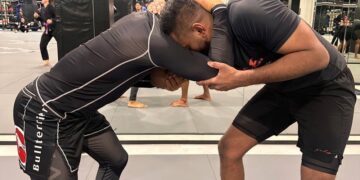
Mixed Martial Arts is a dynamic combat sport that combines elements of other martial arts. Although many fighters aim to land a flashy one-punch knockout, striking in combination is often much more effective. Even fighters gifted with dynamite knockout power can benefit from learning to better use combinations. Utilizing combinations makes a fighter less one-dimensional and gives them a deeper striking game. Today, Evolve Daily is pleased to share six of the most effective MMA combinations you need to master.
1) Double Jab – Power Strike
The double jab to power strike is a tried and true staple combination found in boxing that can be used effectively in MMA. You can use the double jab to set almost any power strike, for both the lead and rear side. One commonly used combination is the double jab to overhand. The double jab serves as a setup for the third punch. This means landing both jabs with power is not a priority; you want to use the double jabs to blind and occupy your opponent’s guard while you move into position to land your overhand.
Fighters who are southpaw or ambidextrous can further utilize the double jab exploiting the angles of an open stance. Southpaws, and orthodox fighters facing a southpaw, can use the double jab to take the outside angle, opening up a pathway for their rear-side strikes.
A variation of this combination involves replacing the jabs with a long guard or hand control of some form. This can be anything from a pin, post, or hand trap from the lead side. For example, at close range, you can pin both of your opponent’s arms by placing your lead forearm across both of their hands. This can leave you with an opportunity to throw your rear power strike while occupying your opponent’s guard.
At mid to long-range, you can post or use a long guard to control your opponent’s movement and set up your rear power strike. Conor “Notorious” McGregor used this exact combination to knock out Jose Aldo.
More recently, Sean O’Malley used a hand trap to right cross combination to capture the UFC Bantamweight Championship Belt.
2) Feint High – Body Shot – Head Shot
The sequence of feinting high to a body shot to a head shot is a common tactic that is useful for landing big power strikes to your opponent’s head. The feint to the head gets your opponent to raise their guard, opening their body up for a split second. Your opponent is likely to respond to your body shot by dropping their guard towards their body, allowing you to land a strike to their chin. This sequence can be done in a myriad of ways, we will discuss a few examples below.
John Lineker, former ONE Bantamweight MMA World Champion, often uses this sequence to set up his devastating lead hook. Lineker will close the distance using a jab feint, throw a right cross to the body, and then explode into a lead hook aimed at his opponent’s chin. Lineker aims his right cross at his opponent’s rear elbow; this knocks the rear arm out of the way and creates a path for his left hook.
The question mark, or Brazilian kick can be set up and landed on your opponent with the above sequence. Feint a jab to start, then throw a front kick, with either leg. Aim your front kick at your opponent’s body and dig into their midsection using the ball of your foot. This will cause your opponent’s guard to drop lower when you kick, leaving an opening for your Brazilian kick. If your opponent does not drop their guard in response to your front kick, use the big toe to kick instead of the ball of your foot. Aim for your opponent’s bladder or solar plexus, as these are soft areas that are easy to damage. Muay Thai legend Jean Charles Skarbowsky explains how to front kick, or teep, using the big toe in the video above.
The technique of the Brazilian kick itself is a combination of a front kick and a head-level roundhouse kick. You start the Brazilian kick by lifting your knee and chambering for a front kick. Instead of snapping your front kick, you rechamber your kicking leg horizontally as you pivot your heel forward on your standing leg. Whip your foot in an arc towards your opponent’s head as you snap your kick. Your foot should land at a downward angle, bypassing your opponent’s shoulder and guard.
Above is a video highlight of Kickboxing legend Glaube Feitosa, who originally popularized the question mark kick, landing and knocking opponents out with his Brazilian kick.
3) Liver Shot Combinations
The liver shot is arguably the most effective strike in combat sports. Just one liver shot landing clean can end a fight instantly, or at the very least drain your opponent’s stamina and will to fight greatly. This is due to the connection between the vagus nerve, which runs through your liver, and your legs. A good liver shot will at the minimum severely limit your opponent’s footwork, leaving them a sitting duck. We will discuss several different combinations that target the liver below.
One way to land the liver shot is to feint the right hand. Doing so will get your opponent’s guard up, leaving you a window for your liver shot. The effectiveness of this technique increases if you land a few right crosses first. Even if your right cross is blocked, your opponent will become conditioned to blocking or shelling up when they see your right cross starting.
Another combination to land the liver shot comes from MMA legend Bas Rutten. Bas would often throw an exaggerated left hook to set up his left-body kick. The left hook is thrown to bring your opponent’s guard up and distract them from your right foot, which steps forward as the hook is thrown. After your right foot lands, immediately explode into your left body kick, aiming for your opponent’s liver.
A low kick-to-back kick combination can be devastating when aimed at the liver. The initial low kick conditions your opponents to associate your kicks, with them blocking one side of their body. The backkick exploits this and will often cause your opponent to freeze for a split second, uncertain of which side to defend. As the backkick is a powerful kick, this is almost a guaranteed knockout if you can land it flush. Above is YouTuber Micah Brock, also known as Kwonkicker, using this combination to win a professional Muay Thai bout in Thailand.
Hand pinning and controls are another effective way to land a liver shot. Hand trapping and hand pinning are forms of control; this means their primary objective is to manipulate positioning rather than causing damage.
For example, you can weave and step to your left to set up your liver shot, but your opponent will often move out of the way or track your movement and land their strikes. To remedy that, pin their arms to their head using your right forearm to create a frame. This will prevent them from punching you and also disrupt their movement. Jeff Chan of MMA Shredded demonstrates this in the video clip above.
Another way to use hand controls to land a liver shot is to use your lead arm to control your opponent’s guard. You can throw a slapping hook to your opponent’s head, causing them to raise their guard. As you make contact with your opponent’s guard, reload your lead side and land a hard liver punch underneath your opponent’s now raised guard. Shane Fazen of Fight Tips explains and demonstrates the above concepts and techniques in the video above.
4) Punches To Leg Kicks
Leg kicks are one of the most effective and devastating strikes in MMA. However, leg kicks are also difficult to land against a live opponent. Using your boxing combinations can occupy your opponent’s guard and attention long enough for you to land a hard leg kick before they can react. This is essentially Dutch-style kickboxing and is optimal for anyone with an especially powerful leg kick.
A classic combination for any style kickboxer is jab-cross-lead hook-rear leg kick. The jab and cross get your opponent to raise their guard. Your lead hook shifts your opponent’s weight to their lead side. This is important as putting your opponent’s weight over the leg that you are kicking minimizes the risk of your kick being checked or avoided.
Another combination that uses boxing to set up leg kicks is the jab-cross-lead leg kick. The jab-cross occupies your opponent’s guard and also squares you up in preparation for the lead leg kick. After landing your cross, do a quick switch step and kick the inside of your opponent’s lead leg. This area is often far less conditioned than the outside of the leg and can wear your opponent down quickly. Above is a video by former MMA fighter and kickboxer Duane Ludwig explaining and demonstrating more Dutch-style kickboxing techniques and drills.
5) Same Side Attacks
Combinations in any combat sport often alternate sides, to take advantage of rotational power and optimize striking flow. However, this also makes it fairly easy to predict your opponent’s next punch in a combination. Using same-side attacks exploits the expectation that your next strike will come from the opposite side of your previous one.
Same-side attacks are consecutive strikes executed by the same side. An example of this would be throwing a lead hook to your opponent’s head, then immediately throwing a liver punch with your lead hand. After blocking your first lead hook, your opponent expected you to follow up with a punch off of your rear hand.
One common same-side attack that has been scoring knockouts is the cross-to-rear high kick. Leon Edwards used this to capture the UFC welterweight championship belt against Kamaru Usman. Edwards, a southpaw, threw his left cross as a feint, following up immediately with a left high kick that landed flush.
Justin Gaethje used this exact combination to knock out Dustin Poirier in their second fight. This highlighted this combination’s effectiveness in an open stance matchup, as both Edwards and Gaethje faced opponents in the opposite stance.
6) Jab – Cross
A staple in boxing, the jab-cross combination can also be used effectively for MMA. To consistently land your jab-cross combination, you must first establish your jab against your opponent. Do this by testing your opponent’s defenses and reactions against your jab. Your jab does not even have to land flush for it to be effective. Jabbing at your opponent’s guard keeps you at a safer distance and can still draw out reactions. After you jab, move laterally or backward to reset the exchange and start again. Doing this will condition your opponent to expect movement after your jab. They will eventually chase you after you throw your jab; this is the perfect opportunity to throw your cross and catch your opponent coming forward.
After landing your cross, you have a myriad of options to choose from. If your opponent is stunned and frozen in place, you can follow up with a lead spear elbow and a rear-slashing elbow. The lead spear elbow will split your opponent’s guard down the middle and get them to shell up, leaving an opening on the side for your rear-slashing elbow.
If your opponent moves back to avoid your jab-cross combination, you can follow up with a longer-range strike such as a teep, roundhouse kick, or gazelle hook to keep them on their back foot.
An effective variation to the jab-cross is the jab-rear overhand. This is a staple for MMA as the overhand is a powerful strike that can be used to both deter and set up grappling exchanges in the cage. Josh Emmet recently used an overhand to knock out his opponent Bryce Mitchell in the first round.
Conclusion
Regardless of your individual fighting style, the above combinations and concepts will help you land more strikes in sparring and level up your striking. Let us know which of these works best for you!
You may also like:
A Guide To The Southpaw Stance In MMA
The Southpaw stance is the standard stance for left-handed fighters in mixed martial arts, but that doesn’t mean right-handed fighters shouldn’t use it to give themselves strategic advantages. Saying a fighter is in a southpaw…
Attacking and defending from different angles is a key aspect of MMA. When two fighters square off, they are in a fifty-fifty situation, with both of their centerlines facing each other. This leaves both fighters…
So you want to be a fighter? Learning effective techniques you can use inside a cage is only half of the equation when it comes to mixed martial arts. How much power you have or…
As an MMA fighter, you’re always looking for techniques that give you an edge inside the cage. Judo, with its focus on throws, holds, and submissions offers a wealth of techniques that can be highly…
Cheat meals have become an increasingly popular concept in sports like mixed martial arts that require participants to have low body fat percentages or make weight for their competitions. There’s a common misconception that cheat…
The clinch is an essential aspect for any MMA fighter. It is the range of combat between stand-up striking and grappling on the floor. Strikers can utilize the clinch to keep the fight standing and…
Every BJJ match starts with the standup and is followed by closing the distance. In grappling, the first physical contact we make with the opponent is establishing our grips. Strong grips allow grapplers to work…
While Thailand is the spiritual and historical home of Muay Thai, it has truly developed into a global sport that is taught and fought the world over. Many foreign-born fighters, known as Muay Farang, have…
As a martial artist, your journey isn’t just about mastering techniques or winning bouts; it’s also about challenging and overcoming stereotypes. One such stereotype is the belief that a vegan diet cannot support the demanding…
You already know how martial arts will improve every aspect of your life. From your physical conditioning, to your health and wellness, and even your confidence and concentration, martial arts has many benefits to the…
Escape the heat and hustle of Singapore with our list of the five best quiet cafes to work, study or chill in. Whether you’re a student needing a peaceful place to hit the books or…
In Brazilian Jiu-Jitsu, a great opponent is the one that is difficult to submit. A good defense creates a pathway to offense. As the idea of position before submission is critical, submissions are usually executed…


































